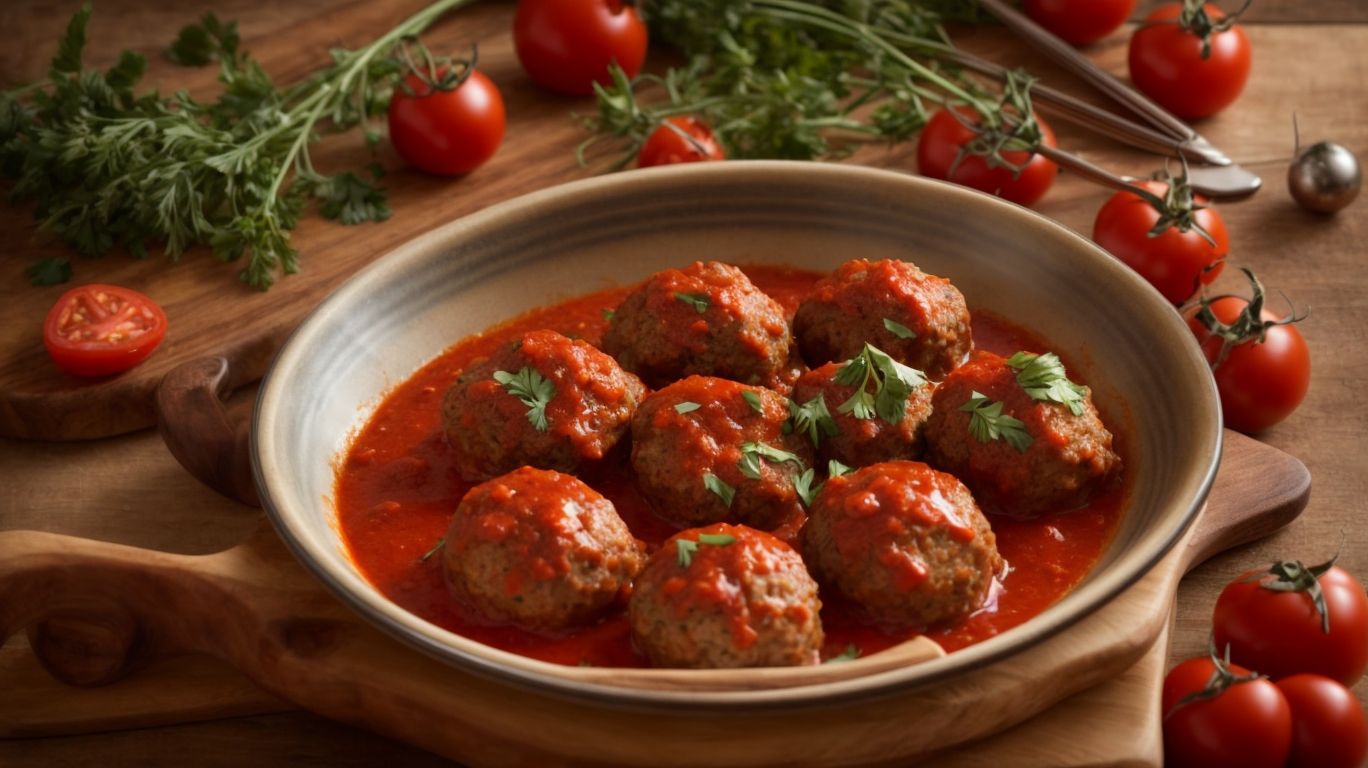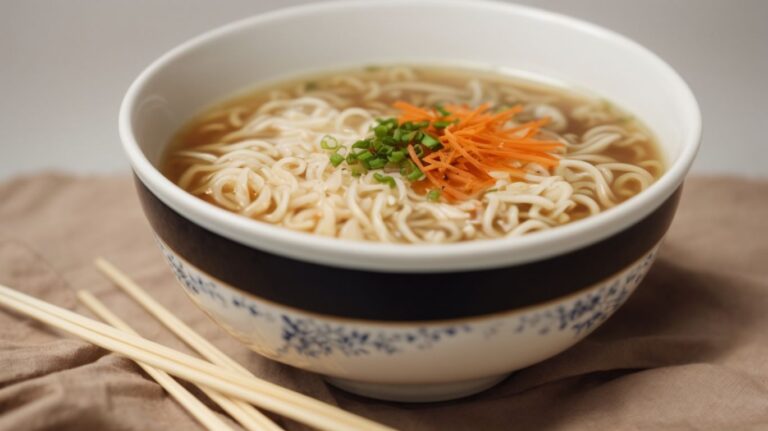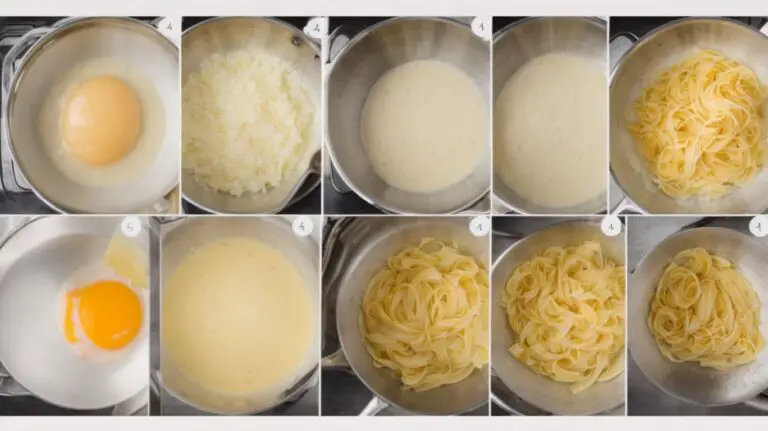How to Cook Meatballs With Sauce?
Are you looking to impress your dinner guests with a delicious and hearty meal? Look no further than this recipe for homemade meatballs with a rich and flavorful sauce.
We will walk you through the ingredients needed for both the meatballs and the sauce, as well as the step-by-step preparation process.
By the end of this article, you’ll be ready to serve up a mouth-watering dish that will have everyone coming back for seconds. Let’s get cooking!
Key Takeaways:
Ingredients for Meatballs
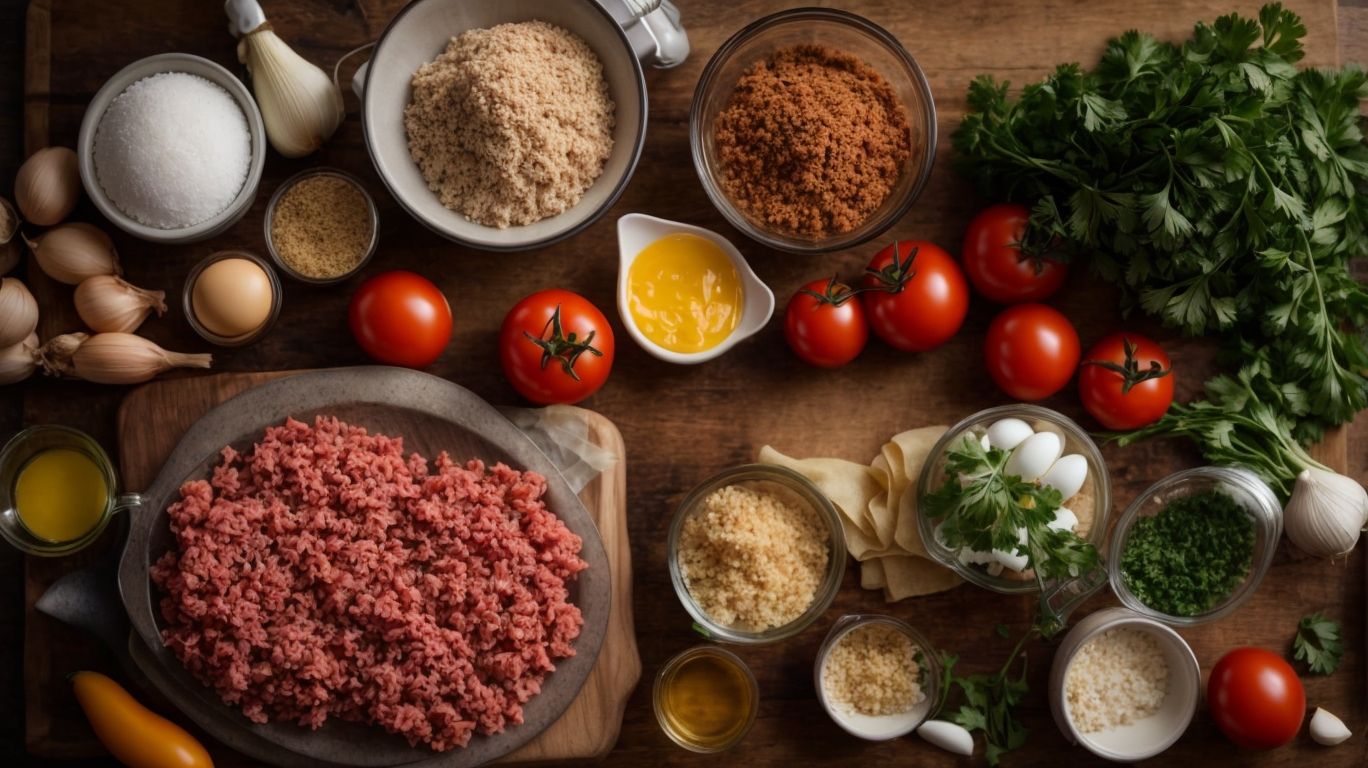
Credits: Poormet.Com – Gerald King
Creating delicious meatballs requires a blend of high-quality ingredients such as ground beef, ground pork, eggs, garlic, breadcrumbs, and fresh parsley.
Ground beef and ground pork bring a rich and savory flavor profile to the meatballs, complementing each other beautifully. The breadcrumbs play a crucial role as a binder, helping to hold the meat mixture together and lending a desirable texture to the final dish.
The aromatic garlic adds depth and complexity to the flavor profile, infusing the meatballs with a delightful savory undertone. Fresh parsley not only provides a pop of color but also contributes a fresh and herbaceous note that cuts through the richness of the meat.
Ground Beef
Ground beef serves as the foundation of meatballs, providing a rich and savory base for the dish.
When selecting ground beef for meatballs, it is essential to consider the ideal fat content, typically aiming for around 15-20% fat for juicy and tender meatballs. The fat content plays a crucial role in the texture and flavor of the meatballs, ensuring they are succulent and flavorful after cooking. Proper seasoning with a balanced blend of herbs and spices is key to enhancing the taste profile. Quality beef with good marbling will infuse the meatballs with a rich, beefy flavor, elevating the overall culinary experience.
Ground Pork
Incorporating ground pork into the meatball mixture adds a depth of flavor and succulence to the dish.
Ground pork is known for its ability to provide moisture and richness to meatballs, making them juicier and more tender in every bite. When combined with seasonings like garlic, onion, breadcrumbs, Parmesan cheese, and herbs such as parsley and basil, the pork flavor becomes even more pronounced and harmonizes beautifully with the other ingredients. Italian seasoning blends, with their classic mix of oregano, thyme, and rosemary, can lend a Mediterranean flair to your meatballs, enhancing their overall taste profile and making them a hit at any dinner table.
Bread Crumbs
Bread crumbs act as a crucial binder in meatballs, providing the desired texture and structure to the final dish.
When incorporated correctly, bread crumbs help absorb excess moisture from the meat mixture, keeping the meatballs moist but not overly wet. They help hold the meatballs together during cooking, preventing them from falling apart. This absorption property of breadcrumbs not only contributes to the perfect consistency but also enhances the overall juiciness of the meatballs.
Parmesan Cheese
The addition of Parmesan cheese to meatballs imparts a rich and savory flavor, elevating the taste profile of the dish.
Parmesan cheese serves a crucial role as a seasoning agent in meatball recipes, adding depth and complexity to the overall taste. Its nutty and salty notes complement the other ingredients perfectly, creating a harmonious flavor profile. Parmesan cheese acts as a binding agent, helping to hold the meatball mixture together and providing a desirable texture. The umami-rich characteristics of Parmesan further enhance the savory notes of the meat, making each bite a delightfully flavorful experience. Parmesan cheese elevates meatballs from a simple dish to a gourmet culinary delight.
Milk
The inclusion of milk in meatball recipes adds a subtle creaminess and enhances the overall flavor profile of the dish.
Adding milk to meatballs has a significant impact on their texture. The proteins in the milk help bind the ingredients together, resulting in tender and succulent meatballs.
This moisture from the milk also prevents the meatballs from becoming dry during cooking, ensuring a moist and juicy final product. The dairy component brings a unique richness and depth to the flavor profile, contributing to the overall aroma and taste of the meatballs.
Eggs
Eggs play a vital role in meatballs as they act as a binding agent, ensuring the ingredients hold together while adding richness to the dish.
Eggs play a crucial part in the texture of meatballs. When mixed into the ground meat and other ingredients, eggs help to trap moisture, keeping the meatballs juicy and tender during cooking. This is due to the proteins in the egg forming a network that holds onto the liquid, preventing the meatballs from becoming dry.
Moreover, eggs contribute to the overall flavor profile by helping the meatballs retain their shape while cooking, allowing them to cook evenly and leading to a satisfying bite every time.
Garlic
Garlic is a key ingredient in meatballs, infusing the dish with a robust flavor profile and aromatic essence.
When preparing meatballs, the incorporation of garlic cloves plays a vital role in elevating the taste experience. Garlic’s pungent yet sweet undertones complement the meat, enhancing the savory richness of the dish. It not only adds depth to the flavor but also contributes to a tantalizing aroma that fills the kitchen during cooking. Whether minced, crushed, or roasted, garlic releases its distinctive essence, permeating the entire mixture to create a harmonious blend of flavors.
Salt and Pepper
Salt and pepper are essential seasonings in meatball recipes, providing a balance of flavors and enhancing the taste profile of the dish.
Kosher salt is favored by many chefs due to its coarse texture, which helps it stick to the surface of the meatballs, ensuring even distribution of flavor. Its larger flakes also make it easier for beginners to control the saltiness level. Meanwhile, black pepper brings a warm, pungent kick that complements the richness of the meat.
When seasoning meatballs, it’s crucial to achieve a harmonious blend of salt and black pepper – too little may result in blandness, while too much can overpower the other flavors.
Ingredients for Sauce
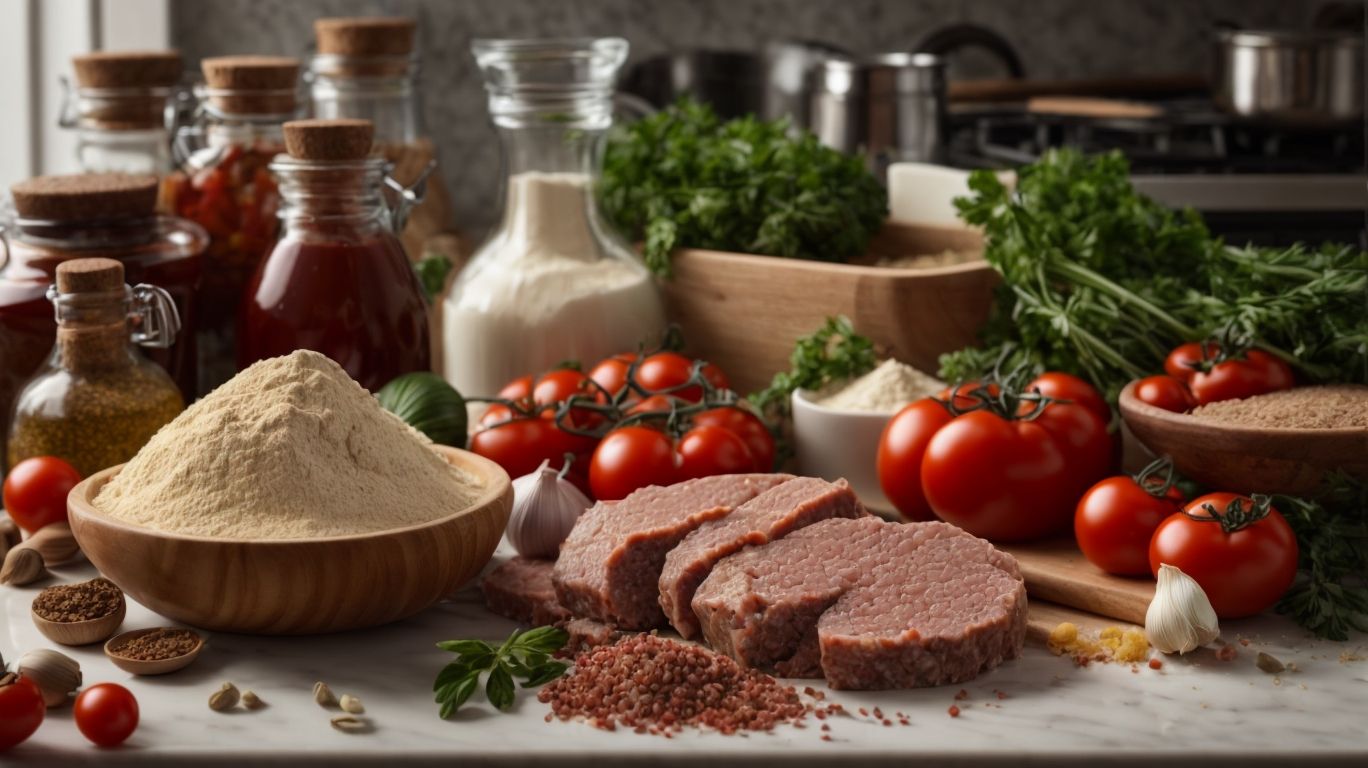
Credits: Poormet.Com – Joshua Jackson
The sauce for meatballs requires a harmonious blend of ingredients such as crushed tomatoes, onion, garlic, olive oil, fresh basil, and a touch of salt and pepper.
Each ingredient plays a crucial role in creating a rich, savory base for the meatballs. The crushed tomatoes provide a robust and tangy flavor, while the onion and garlic add depth and complexity. The olive oil contributes to the smooth mouthfeel, coating each meatball in lusciousness. Fresh basil infuses a burst of freshness and herbaceous notes, elevating the overall aroma. The seasoning of salt and pepper ties everything together, balancing the flavors perfectly.
To enhance the sauce’s taste profile, consider simmering it slowly to allow the flavors to meld and develop further.
- For a richer taste, you can add a splash of balsamic vinegar or a sprinkle of sugar to enhance the sweetness.
- Experiment with different herbs like thyme, oregano, or rosemary to add layers of complexity.
Texture-wise, blending the sauce or leaving it slightly chunky can offer contrasting experiences. Ultimately, the sauce’s quality is the cornerstone of delectable, succulent meatballs that will tantalize your taste buds.
Crushed Tomatoes
Crushed tomatoes form the heart of the sauce for meatballs, offering a rich and tangy base to complement the dish.
When simmered gently, crushed tomatoes release their natural sweetness while adding depth to the sauce. Their thick consistency helps bind all the flavors together, ensuring a harmonious blend of herbs, spices, and savory elements. This simmering process is crucial as it allows the flavors to meld and intensify, creating a robust and appetizing profile that coats each pasta strand and meatball with a delicious coating. The acidity of crushed tomatoes also balances out the richness of the meatballs, resulting in a well-rounded flavor profile that keeps you coming back for more.
Onion
Onions play a crucial role in sauce preparation, adding a sweet and savory depth of flavor to the dish.
When sautéing onions for sauce development, the key is to cook them slowly over low heat until they turn translucent and begin to caramelize. This process not only softens the onions but also intensifies their natural sugars, creating a rich and complex flavor profile that enhances the overall taste of the sauce. Caramelization is what gives the sauce its depth and complexity, making it more than just a bland base. Plus flavor, onions release compounds that contribute to the sauce’s enticing aroma, enticing diners even before tasting the dish.
Garlic
Garlic serves as a flavor powerhouse in the sauce for meatballs, infusing the dish with a distinctive aroma and taste profile.
When minced or sautéed, garlic releases its pungent yet savory essence, enhancing the overall richness of the sauce. Its versatility allows it to play a dual role, providing both a subtle underscoring flavor as well as a pronounced punch, depending on how it is prepared. Mixing garlic with tomatoes, herbs, and a hint of olive oil creates a robust base for pasta that beautifully complements the savory meatballs. The slow simmering process allows the complex flavors to meld together, resulting in a harmoniously balanced sauce that coats each noodle and meatball with deliciousness.
Olive Oil
Olive oil lends a luxurious mouthfeel and a touch of Mediterranean flair to the sauce for meatballs, enriching the overall taste experience.
In terms of Italian-inspired sauces, olive oil plays a crucial role as the base that carries the flavors of herbs, spices, and other ingredients. A high-quality olive oil can bring a depth of flavor and silkiness to the sauce, coating each meatball with a luscious sheen.
The versatility of olive oil extends beyond just cooking; a drizzle of it over pasta dishes not only enhances the taste but also imparts a velvety texture that envelops the pasta strands, creating a harmonious blend of flavors. The richness and fruity notes of olive oil bind all the elements together, transforming a simple dish into a gourmet experience.
Basil
Fresh basil brings a vibrant herbal note to the sauce for meatballs, infusing it with a touch of Italian authenticity and freshness.
Basil is not only a key ingredient in Italian sauces but also a versatile herb that adds depth of flavor and aroma to a myriad of dishes. When used as a garnish, basil’s bright green leaves provide a visually appealing contrast to the rich red of tomato sauces or creamy white of Alfredo. Its subtle peppery undertones complement the savory elements in meatballs, enhancing the overall taste profile. The herb’s fresh and slightly sweet fragrance elevates the dish, making it a sensory delight.
Salt and Pepper
Salt and pepper act as the pillars of flavor in the sauce for meatballs, balancing the taste profile and enhancing the overall Italian essence of the dish.
In terms of sauce seasoning, salt is essential for highlighting the natural flavors of the ingredients, while pepper adds a subtle heat and depth to the overall taste. The combination of these two simple yet powerful ingredients not only brings out the rich umami flavors of the meatballs but also elevates the sauce to a new level. Salt helps to draw out the flavors present in the ingredients, while pepper adds a layer of complexity that keeps the taste buds intrigued.
Preparation of Meatballs
The preparation of meatballs involves a series of steps including mixing the ingredients, shaping the meatballs, and browning them to achieve a tender and flavorful texture.
When mixing the ingredients, it’s essential to ensure that the flavors are evenly distributed throughout the meat mixture. This can be achieved by gently combining the ground meat, breadcrumbs, herbs, spices, and other seasonings in a large mixing bowl until well incorporated. The next step involves shaping the meatballs into uniform sizes to ensure even cooking. Rolling the mixture into round balls of similar sizes helps in achieving consistent cooking results.
Mixing the Ingredients
Mixing the meatball ingredients is a crucial step in ensuring a harmonious blend of flavors and seasonings for the perfect meatball.
Thoroughly mixing the ingredients allows the flavors to meld together seamlessly, creating a more balanced taste in every bite. When combining the seasonings, it is essential to sprinkle them evenly throughout the mixture to avoid pockets of overpowering flavors. One effective technique to blend the seasonings uniformly is to add them gradually, layer by layer, while gently folding the mixture. This meticulous process ensures that each meatball is bursting with a consistent burst of flavors. Hands-on mixing not only distributes the seasonings effectively but also helps in binding the ingredients together, resulting in a tender and flavorful meatball.
Shaping the Meatballs
Shaping the meatballs into uniform 2-inch sizes ensures even cooking and consistent meatball texture throughout the dish.
When shaping the meatballs, it is crucial to use your hands to gently roll the mixture into rounded balls. To maintain a consistent size, you can use a cookie scoop or a measuring spoon. This will not only ensure that each meatball cooks evenly but also enhances the overall aesthetic of your dish. Remember to apply gentle pressure while shaping to prevent dense meatballs. For a professional touch, consider using a shaping tool or mold to create perfectly symmetrical meatballs.
To further enhance uniformity, place the shaped meatballs on a flat surface to double-check their size and shape before cooking. This extra step guarantees that your meatballs are visually appealing and cook uniformly, providing a delightful eating experience for everyone at the table.
Browning the Meatballs
Browning the meatballs in a skillet over medium-high heat creates a flavorful crust that enhances the overall texture and taste of the dish.
This crucial step is where Maillard reaction comes into play, creating those savory browned bits that add depth to the flavor profile. Achieving a proper sear not only gives a pleasant crunch but also locks in the juices, keeping the meatballs moist and succulent. The ideal heat level here is crucial – too low, and the meatballs might simmer instead of sear, resulting in a lackluster appearance; too high, and the outside burns before the inside is cooked through.
Preparation of Sauce
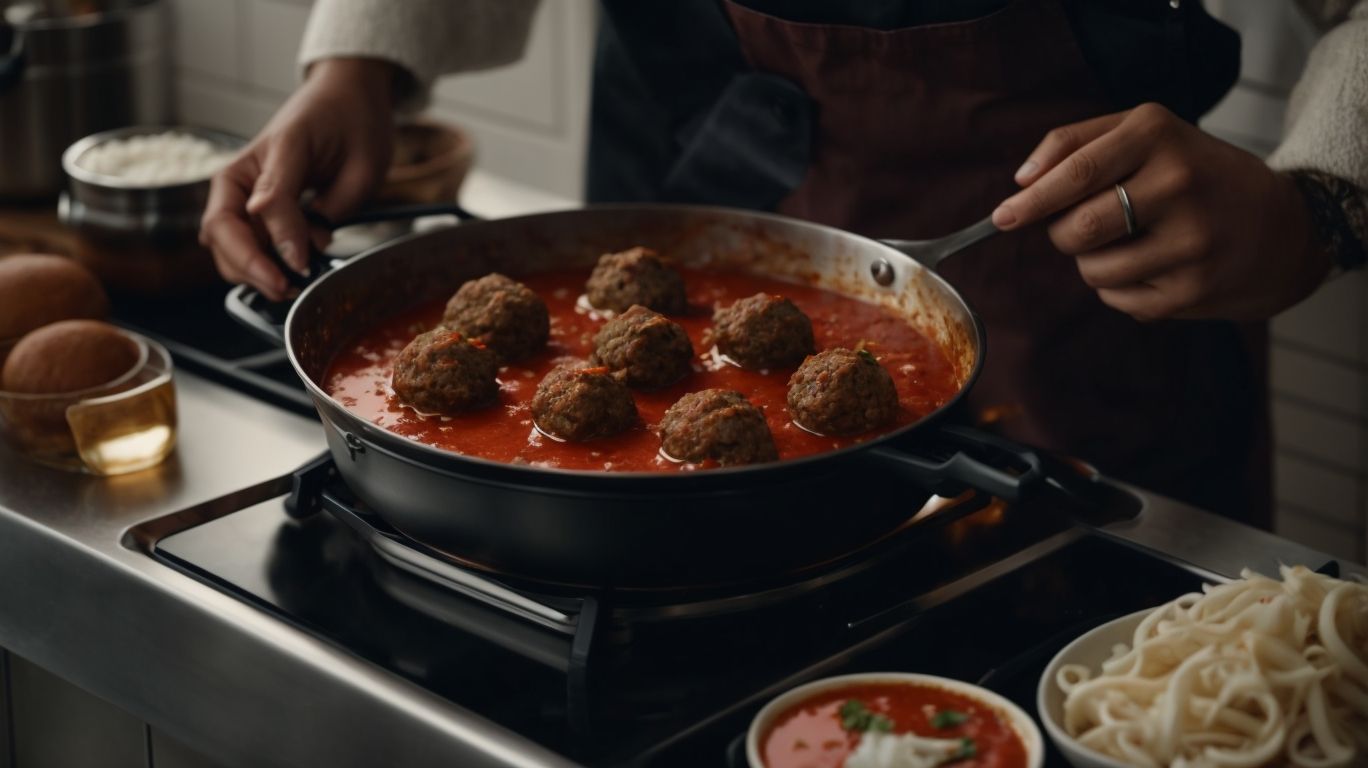
Credits: Poormet.Com – Roger Williams
The preparation of the sauce involves sautéing aromatics, simmering the ingredients, and infusing the pasta and meatballs with an aromatic and flavorful Italian essence.
When sautéing aromatics like garlic and onions, the key lies in gently heating them in hot oil until they release their rich, fragrant oils, adding depth and complexity to the sauce. The process requires a watchful eye to prevent burning, as overcooking can result in a bitter taste.
Simmering the ingredients together, on the other hand, allows flavors to meld and intensify as the sauce reduces, creating a harmonious blend of tastes. This slow and gentle cooking method enhances the overall richness of the sauce, bringing out the nuances of each component.
The sauce acts as the unifying element of the dish, enveloping the pasta and meatballs with its luscious coating, infusing every bite with the essence of herbs, spices, and other ingredients used in its preparation. It serves as the soul of the dish, tying together all the flavors and textures to create a memorable dining experience.
Sautéing the Onion and Garlic
Sautéing the onion and garlic forms the flavorful base of the sauce, enhancing the dish with their aromatic essence and caramelized notes.
When the diced onions hit the hot skillet, their natural sugars start to caramelize and turn golden brown, creating a depth of flavor that is essential for a well-rounded sauce. The garlic follows suit, releasing its pungent aroma and adding layers of complexity to the dish.
As the onions and garlic continue to cook, their flavors intensify, infusing the oil with a rich, savory taste that will permeate the entire sauce. The gradual caramelization process not only adds sweetness but also a hint of nuttiness, elevating the overall profile of the dish.
Adding the Crushed Tomatoes
Incorporating crushed tomatoes into the sautéed aromatics initiates the sauce’s journey towards a rich and velvety texture that complements the pasta and meatballs.
As the crushed tomatoes blend with the sautéed aromatics, a delightful transformation occurs. The simmering process not only intensifies the flavors but also allows the tomatoes to release their natural sweetness, tanginess, and umami undertones, creating a symphony of flavors. These tomatoes act as the foundation of the sauce, binding together the herbs, spices, and meats, enhancing each ingredient’s characteristics.
Simmering the Sauce
Simmering the sauce allows the flavors to meld together, creating a depth of flavor that enhances both the meatballs and the pasta in the dish.
When the sauce is slowly simmered, the ingredients have time to release their essence into the mixture, intensifying the taste experience. This process helps marry the individual flavors, resulting in a harmonious blend that coats every bite of meatball and pasta.
The extended simmering time not only deepens the flavors but also thickens the sauce, giving it a rich and velvety texture that clings perfectly to the meatballs and pasta. The magic of simmering lies in how it transforms the humble sauce into the unifying element that brings all the components of the dish together.
Combining Meatballs and Sauce
The fusion of tender meatballs with the velvety sauce results in a culinary harmony where each bite offers a burst of flavor and satisfaction.
The process of combining these succulent meatballs with the rich, flavor-packed sauce involves gently submerging the meatballs into the simmering sauce, allowing the flavors to meld together beautifully. The slow simmering method ensures that each meatball absorbs the essence of the sauce, becoming tender and infused with the distinctive flavors of the dish.
As the meatballs simmer in the sauce, the aromas fill the kitchen, tantalizing the senses and building anticipation for the perfect pairing with al dente pasta. The result is a delectable union that pasta lovers savor with each forkful, relishing the intricate flavors and texture combination that create a truly memorable dining experience.
Adding the Meatballs to the Sauce
Adding the browned meatballs to the simmering sauce allows them to absorb the rich flavors and become infused with the essence of the dish.
This integration process is a crucial step in Italian cuisine as it ensures that every bite is bursting with flavors. As the meatballs gently cook in the sauce, they exchange their savory juices, enhancing the overall taste profile. The simmering technique not only softens the meatballs, making them tender and juicy, but also allows the flavors to mingle and develop a harmonious blend. The slow and steady simmering process is key to achieving a perfect marriage between the meatballs and the sauce, creating a delectable dish that is greater than the sum of its parts.
Simmering the Meatballs in the Sauce
Simmering the meatballs in the sauce allows them to absorb the rich flavors, ensuring they remain tender and succulent with each bite.
As the meatballs gently simmer in the sauce, their surface soaks up the savory essence, creating a harmonious melding of flavors. This slow cooking process results in the infusion of the meat juices into the sauce, elevating its taste profile to new heights. The longer the meatballs remain in the bubbling sauce, the deeper the exchange of flavors, enhancing the overall decadence of the dish. This method not only intensifies the taste but also contributes to the tenderness of the meatballs, making them irresistibly soft and juicy.
Serving Suggestions
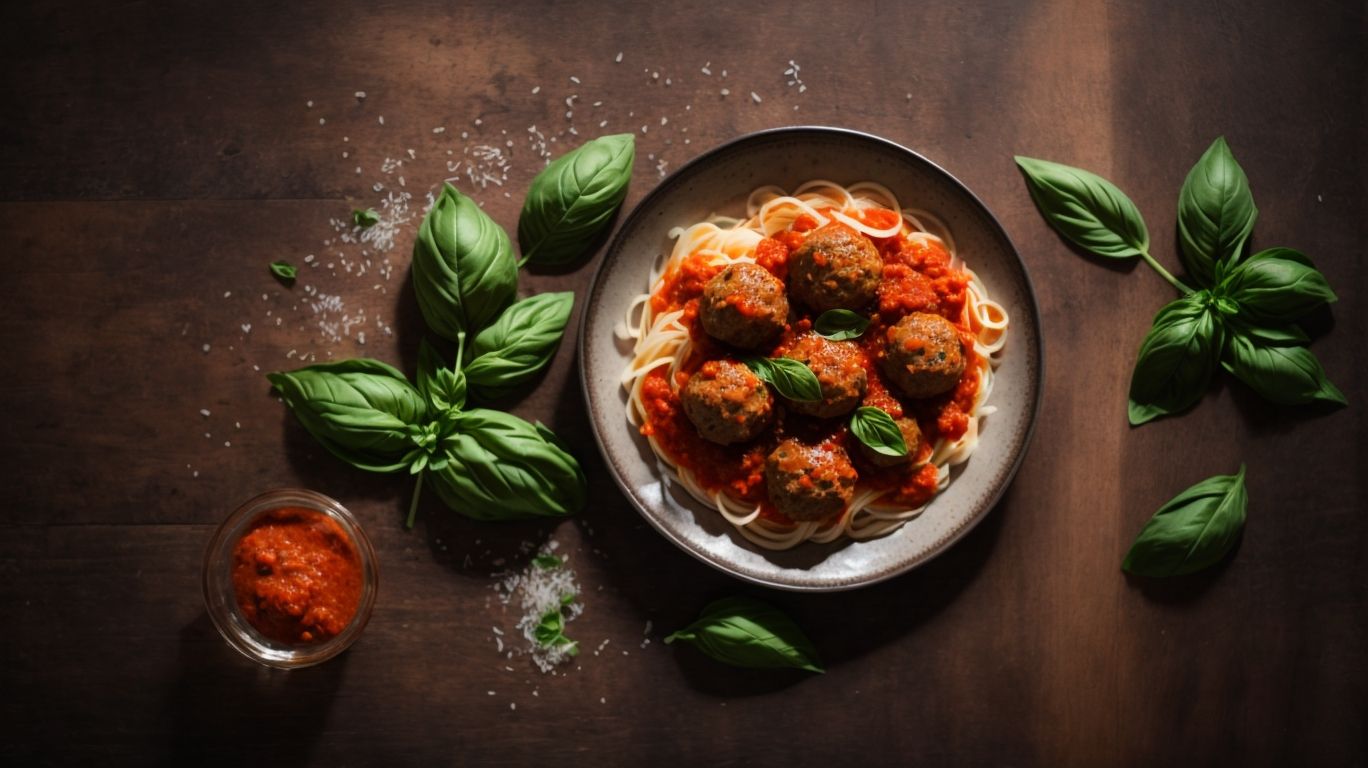
Credits: Poormet.Com – Joshua Wilson
When serving meatballs, consider pairing them with al dente pasta, drizzled with sauce, topped with grated cheese, for a mouthwatering and satisfying meal.
If you want to elevate the flavors further, try serving the meatballs alongside a rich marinara sauce, made with juicy tomatoes, garlic, and herbs, enhancing the depth of the dish. Consider blending different types of cheese, such as Parmesan, mozzarella, or pecorino, to create a melty and savory topping for the pasta, complementing the hearty meatballs perfectly.
- For a complete meal, add a side of garlic bread or a fresh green salad for a well-rounded dining experience.
- Experiment with different pasta shapes like spaghetti, penne, or rigatoni to find your favorite combination with the meatballs.
Frequently Asked Questions
What ingredients do I need to cook meatballs with sauce?
To cook meatballs with sauce, you will need ground meat, breadcrumbs, eggs, herbs and spices, tomato sauce, and any additional seasonings or ingredients you prefer.
Can I use frozen meatballs to make this dish?
Yes, you can use frozen meatballs to cook with sauce. Just make sure to defrost them before cooking and adjust the cooking time accordingly.
What is the best type of meat to use for meatballs?
Traditionally, beef or a combination of beef and pork are used for meatballs. However, you can also use ground chicken, turkey, or even plant-based meat alternatives for a healthier option.
How do I prevent my meatballs from falling apart while cooking?
To prevent your meatballs from falling apart, make sure to mix and handle the meat gently. Overworking the meat can cause the meatballs to become tough and fall apart. Also, adding a binding agent such as eggs or breadcrumbs can help keep the meatballs together.
How long should I cook meatballs with sauce?
The cooking time for meatballs with sauce will depend on the type of meat used and the size of the meatballs. Generally, meatballs should be cooked for 15-20 minutes in a preheated 375°F oven or until they reach an internal temperature of 165°F.
Can I make meatballs with sauce in a slow cooker?
Yes, you can make meatballs with sauce in a slow cooker. Simply add the meatballs and sauce to the slow cooker and cook on low for 4-6 hours or high for 2-3 hours. This is a great option for a hands-off approach to cooking.

